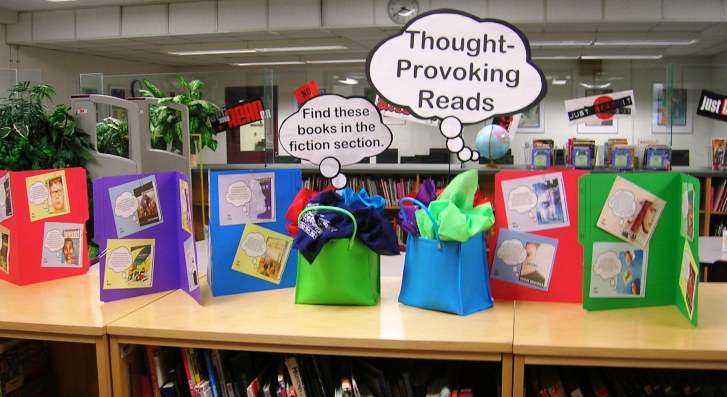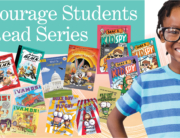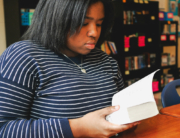When I was asked by my principal to create a skills class for my developing readers nearly 10 years ago, I knew I wanted to incorporate a choice reading program that was structured, but loose enough where students could choose, check and champion their own reading without the risk of an assessment or using reading as a reprimand. I wanted students to make reading decisions based on their interests, but also on their reading level. I wanted them to be empowered by their reading decisions and encouraged by their personal growth.
Choose
First, I created a two-week calendar where reading choice was prominently featured. I didn’t want choice reading to be an afterthought; something students did when they were done with their class work, waiting for the bell to ring. Therefore, I set aside for this specific activity, where students had space, time and quiet to lose themselves in a book.

In addition to the bi-weekly calendar, I added Responsibility Targets. Instead of assessments or tests, I created opportunities for students to share their reading in non-threatening ways. I designed Reading Targets as a way for students to ruminate, reflect and reveal what they had read with me and a broader audience using various methods.
Second, I enlisted the help of our media specialist. We began looking for publishers that specialized in high interest, low readability books. We looked for books beginning with a sixth grade reading level (my students had been tested using MAP (Measures of Academic Progress), and their reading scores tested around a sixth grade reading level). It was also imperative that we find books that had mature themes with adult book covers. Students are often turned off by book covers that look elementary.
Eventually as the reading program took off, the Media Specialist would bring our class the publishing booklets that showcased or announced new publications. I would pass it around and ask students to circle the books that they wanted the Media Specialist to order. While she couldn’t order all of them due to cost, she ordered as many as her budget would allow. As a result, my students appreciated that books were being purchased just with them and their interests in mind.
Check
Next, I spent the summer organizing and planning the structure of my reading program. Since my classroom was attached to the school library, books were always accessible. However, I wanted to have an assortment in my room as well. Therefore, I bought books at rummage sales, libraries and half-price book stores. I knew I wouldn’t be reimbursed for the purchases; but, for my program to be a success, I also knew that I would have to make some financial sacrifices.
In addition, I began designing and searching for assessments meant to evaluate skill building, but not meant to overshadow the goal of the reading program—which was to read. However, I referred to them as “Check-Ins” and not “tests” or “assessments.” Check-Ins were opportunities for students to show me their thinking without the stress of a grade or valuation. I offered feedback and engaged in conversation based on their responses. Check-Ins were not meant to be whole book assessments; rather, just snippets of their thinking. I chose several types of Check-Ins meant to demonstrate differentiation:

- One-Pagers from the book, Readicide: How Schools are Killing Reading and What You Can Do About It written by Kelly Gallagher
- book chats where invited guests could join our book discussions
- main idea/detail and summary graphic organizers
- character traits anchor charts
- post-it notes as placeholders to demonstrate one’s thinking during annotation
Lastly, I created a culminating project where upon finishing the book, each student would write a Summary and Review. The Summary would be approximately ½ page long and would be based on the 5 Ws and How with Summary graphic organizer created by Janet Allen. Students would have had main idea/details and summary instruction already because we would have practiced it as a Check-In. I urged students to end their Summary in a “tease” to encourage other students to read their book.
After the student wrote the Summary, he/she would write a Review. I didn’t want the Review to sound scripted; rather, I wanted students to give their honest opinion of the book based on questions anyone would ask: why did they like the book and why would they recommend it? When the time came to write their Review, we would conference and offer more in-depth information based on their book.
Champion
Week 1
During the first week of school, I explained our two-week calendar and highlighted choice reading to my students. I emphasized the reading goal: To have the opportunity to choose their own reading and share their reading with various audience members in creative and engaging ways. In addition, once they finished reading their book, students would write a Summary and Review for their peers. Then I underscored the purpose: I wanted them to enjoy reading. I acknowledged that many of them probably didn’t know what they liked to read having very little opportunity to choose. I wanted them to have that chance.
We transitioned to the library where the Media Specialist had strategically displayed fifty-sixty young adult books on tables and easels. Inspirational posters of celebrities and rappers were exhibited encouraging reading. The Media Specialist had lapel buttons strewn on the tables that said: “Reading is my Superpower,” “I Read Banned Books,” “Book Junkie” and “Today a Reader; Tomorrow a Leader.” She urged students to take a pin and find a seat.

After her brief introduction, the Media Specialist showed a series of stirring book trailers, meant to arouse curiosity. After each trailer, she held up the book. As each trailer was presented and each book was introduced, students grew more and more restless. They were eager to begin reading.
For 15 minutes during each class period that week, students went to the library or examined the books in my classroom, reading book covers, book jackets and the first several pages. I encouraged students to talk with each other about books: topics they liked, authors they had read, titles they had heard of. By week two, everyone had a book. I noticed that students were “book talking” with their friends: sharing books they thought their friends might like, encouraging each other to “try this one” or “here’s one you might like.”
Week 2
During the next week, we read for 10-15 minutes three times a week. I wanted to help build students’ reading stamina and was concerned that if I gave them too much time they might become fidgety. In addition, I didn’t give them any set purpose, other than to just read. As they read, I sat next to each student, usually for about two minutes and either read quietly with them or asked them questions about the page they were reading.
Week 3
I increased reading time to 20 minutes and I assigned the first Check-In, a One-Pager. After students read, I gave them 7-10 minutes to complete the One-Pager. I read each one and offered feedback usually in the form of more questions or inferred insights based on what they had read.
During the next two weeks, students read and completed another Check-In, a Character Trait anchor chart that highlighted their book’s main character. Again, I offered feedback having “conversations” about their book in the Check-In.
Week 6
By now, students had settled into a reading routine and had completed two Check-Ins. Since I had been reading right along with the students, I created a chart with student names and reading notes. I began to keep track of their book titles and genre interests.
I also introduced that it was time for our first book chat. Students invited teachers, the School Resource Officer, the engineers and the lunch personnel.
The day before our chat, I asked students to write a brief summary of their book on one side of a 3 x 5 notecard. Then on the other side, I asked them to create one statement that would encourage someone to read their book. I wanted the chat to be as organic as possible; I didn’t want scripted conversation. The 3 x 5 card was all that students prepared.
The next day several guests arrived for our book chat. Due to time, not all students were able to share their books, but those that did spoke with passion and enthusiasm. They wanted guests to read their book and were delighted when guests and students asked for more detail.
Week 7
 I set aside time to teach the 5Ws and How with Summary graphic organizer knowing that several students were nearly done with their book. Since this particular skill was critical to their Summary and Review final assessment, it was imperative that students knew how to confidently write this assessment and complete it before beginning their next book.
I set aside time to teach the 5Ws and How with Summary graphic organizer knowing that several students were nearly done with their book. Since this particular skill was critical to their Summary and Review final assessment, it was imperative that students knew how to confidently write this assessment and complete it before beginning their next book.
To practice the assessment, students chose a chapter they had already read. Then I modeled how to complete the graphic organizer and how to write the summary using a page from an iconic children’s book, The Polar Express. Students practiced completing the graphic organizer using the information from their book chapter. Then, using only the information listed on the graphic organizer, they wrote their summary. Many students had a difficult time with this particular part of the practice, since their first inclination was to write a re-telling and not a summary. However, after several practice opportunities, students created a model they could refer to when they were ready to write the Summary and Review assessment.
* * * * *
We know the value of choice reading and how it can change the lives of our students. We know that giving them the chance to live in the lives of their characters builds empathy, sympathy and heart. Let’s give them the opportunity to choose, the confidence to check and the ability to champion their reading lives.
Bibliography
Allen, Janet. More Tools for Teaching Content Literacy. Stenhouse. 2007.
Gallagher, Kelly. Readicide: How Schools are Killing Reading and What You Can Do About It. Stenhouse. 2009.








Leave A Comment